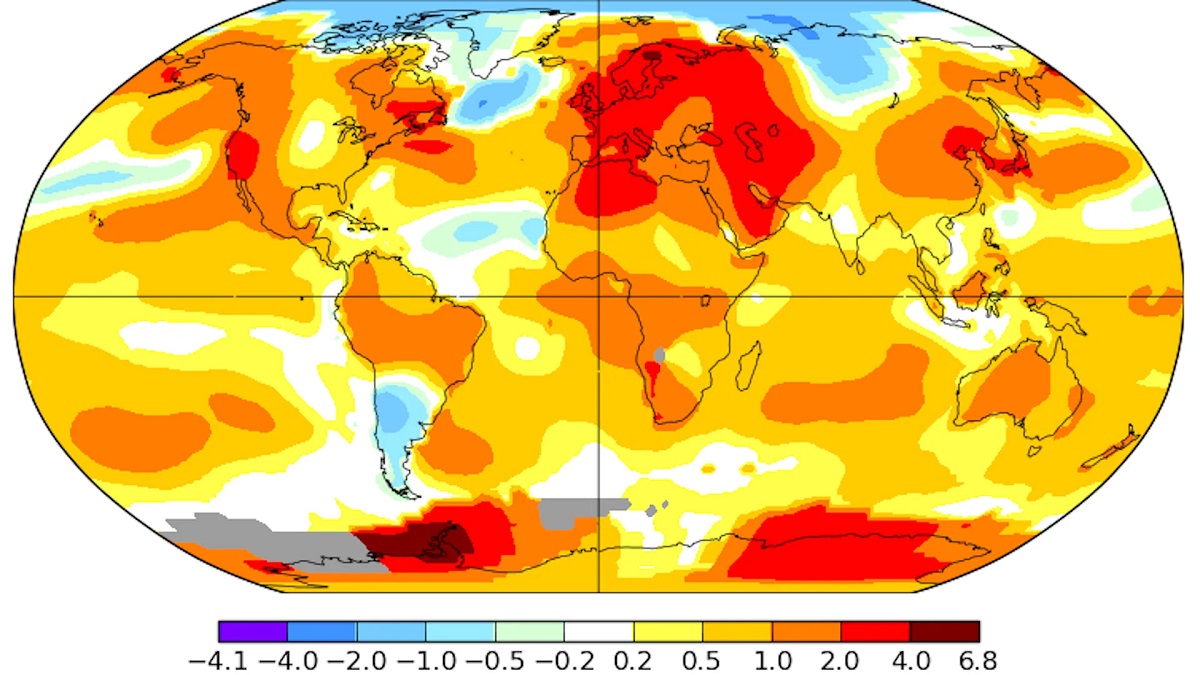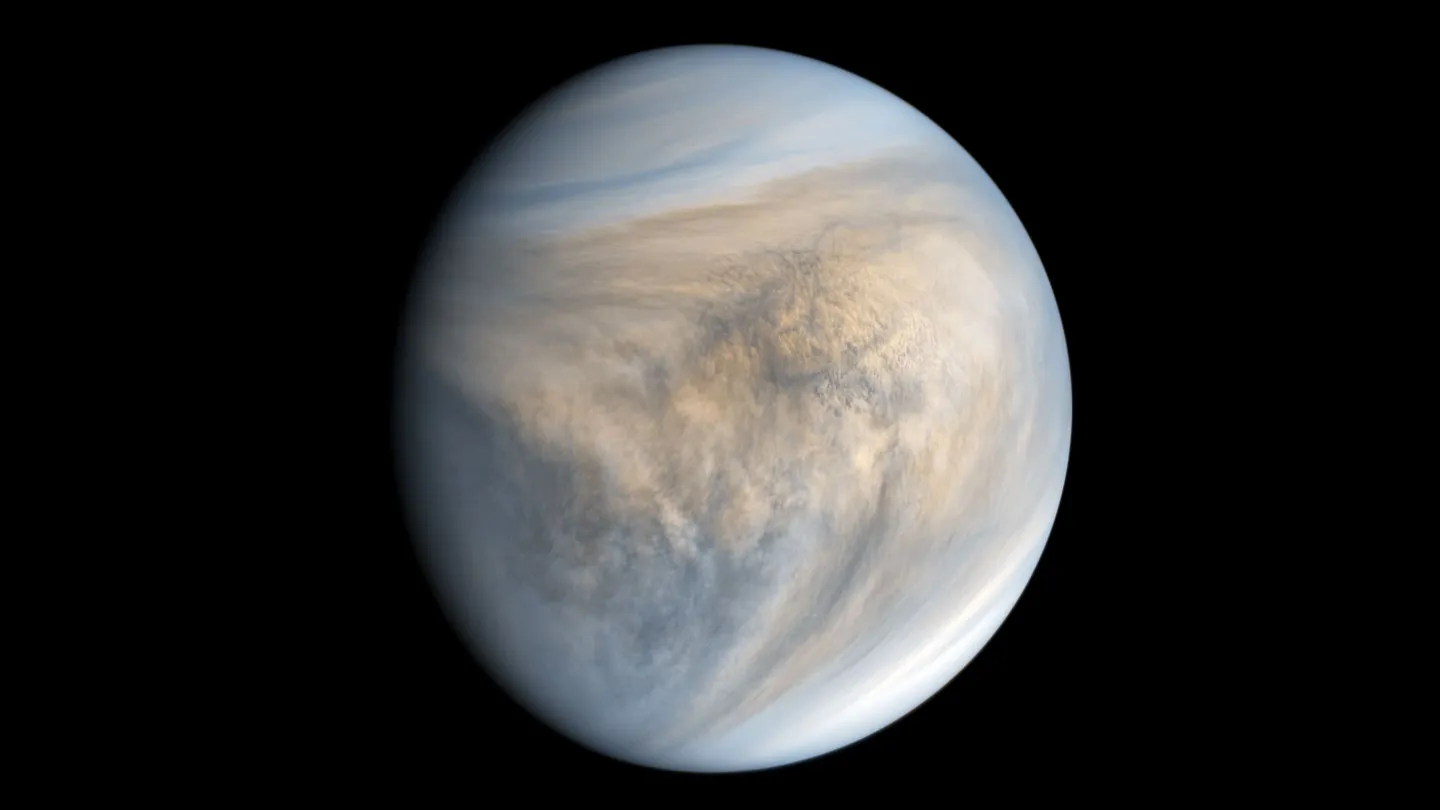Home>Science & Environment>Saturn’s Temperature: Facts And Information


Science & Environment
Saturn’s Temperature: Facts And Information
Published: February 19, 2024
Discover the fascinating facts and information about Saturn's temperature and its impact on the environment. Explore the science behind Saturn's climate and atmospheric conditions. Learn more about the intriguing relationship between science and the environment.
(Many of the links in this article redirect to a specific reviewed product. Your purchase of these products through affiliate links helps to generate commission for Temperatures.com, at no extra cost. Learn more)
Table of Contents
Introduction
Saturn, the sixth planet from the Sun and the second-largest in the solar system, is a mesmerizing celestial body that has captivated the curiosity of astronomers and space enthusiasts for centuries. Known for its stunning rings and distinctive golden hue, Saturn is a gas giant with a complex and dynamic atmosphere. One of the key aspects that scientists and researchers have been keenly studying is the temperature of this enigmatic planet.
Understanding Saturn's temperature is crucial in unraveling the mysteries of its atmospheric dynamics and composition. By delving into the intricate interplay of factors that influence Saturn's temperature, scientists can gain valuable insights into the planet's climate patterns, internal processes, and overall behavior within the solar system.
As we embark on a journey to explore Saturn's temperature, we will delve into the depths of its atmosphere, uncover the factors that shape its thermal environment, and examine the intriguing variations in temperature across different regions of the planet. By shedding light on the significance of studying Saturn's temperature, we aim to illuminate the profound impact that this research has on our understanding of planetary systems and the broader implications for scientific exploration beyond Earth.
Join us as we embark on an illuminating expedition into the realm of Saturn's temperature, where we will unravel the mysteries shrouding this captivating gas giant and gain a deeper appreciation for the intricate mechanisms that govern its thermal equilibrium.
Read more: Mexico’s Winter Chill Facts
Understanding Saturn's Atmosphere
Saturn's atmosphere is a complex and dynamic realm that encompasses a rich tapestry of atmospheric phenomena, including swirling storms, intricate cloud patterns, and a diverse array of atmospheric gases. Composed primarily of hydrogen and helium, with traces of other elements and compounds, Saturn's atmosphere presents a captivating mosaic of features that have intrigued scientists and astronomers for generations.
At the heart of Saturn's atmospheric dynamics lies its mesmerizing cloud bands, which are characterized by alternating light and dark stripes that encircle the planet. These bands are a manifestation of the complex interplay between atmospheric gases and the planet's internal processes, giving rise to mesmerizing patterns that adorn the gas giant's atmospheric canvas.
One of the most striking features of Saturn's atmosphere is its hexagonal polar vortex, a colossal six-sided jet stream located at the planet's north pole. This enigmatic structure, spanning a staggering 20,000 miles in diameter, represents a captivating enigma that continues to puzzle researchers. The intricate dynamics of this hexagonal pattern, coupled with the planet's overall atmospheric circulation, contribute to the mesmerizing atmospheric dynamics that define Saturn's thermal and meteorological characteristics.
Furthermore, Saturn's atmosphere is adorned with a stunning array of cloud formations, including towering thunderstorms and expansive cloud decks that span vast regions of the planet. These clouds, composed of ammonia crystals and other compounds, create a visually striking tapestry that adds to the allure of Saturn's atmospheric landscape.
In addition to its captivating cloud features, Saturn's atmosphere is also characterized by powerful atmospheric phenomena, such as the intense and persistent storm systems that manifest as colossal tempests, including the famous Great White Spot. These immense storms, fueled by the planet's internal heat and atmospheric dynamics, serve as a testament to the sheer power and complexity of Saturn's atmospheric processes.
As we delve deeper into the enigmatic realm of Saturn's atmosphere, we gain a profound appreciation for the intricate interplay of atmospheric dynamics, thermal processes, and planetary-scale phenomena that shape the atmospheric environment of this captivating gas giant. By unraveling the mysteries enshrouding Saturn's atmosphere, scientists and researchers continue to unveil the profound complexities that govern the thermal equilibrium and meteorological phenomena of this enigmatic planet.
Factors Affecting Saturn's Temperature
Saturn's temperature is influenced by a myriad of factors that collectively shape the thermal environment of this enigmatic gas giant. The interplay of these factors gives rise to the complex and dynamic thermal equilibrium that governs the atmospheric and surface temperatures across different regions of the planet. Understanding these influential factors is crucial in unraveling the intricate mechanisms that regulate Saturn's thermal environment and its broader implications for planetary science.
Solar Irradiance:
At the forefront of factors affecting Saturn's temperature is solar irradiance, which plays a pivotal role in determining the amount of solar energy received by the planet. As Saturn orbits the Sun, variations in solar irradiance lead to fluctuations in the amount of energy absorbed by the planet's atmosphere and surface. These fluctuations contribute to seasonal variations in temperature and influence the overall thermal balance of the planet.
Atmospheric Composition:
The composition of Saturn's atmosphere, primarily consisting of hydrogen and helium with traces of other elements and compounds, significantly impacts the planet's thermal properties. Greenhouse gases, such as methane, contribute to the retention of heat within the atmosphere, thereby influencing the overall temperature distribution across different atmospheric layers. The intricate interplay of atmospheric constituents shapes the thermal structure of Saturn's atmosphere, giving rise to diverse thermal profiles across the planet.
Internal Heat:
Saturn's internal heat, stemming from residual heat from its formation and ongoing processes within its core, represents a fundamental factor influencing the planet's temperature. This internal heat source contributes to the overall thermal budget of the planet, influencing atmospheric circulation patterns, cloud formation, and thermal gradients within the atmosphere. The dynamic interplay between internal heat and atmospheric processes shapes the thermal dynamics of Saturn, contributing to its complex and ever-evolving thermal environment.
Atmospheric Dynamics:
The intricate atmospheric dynamics of Saturn, characterized by powerful jet streams, storm systems, and atmospheric circulation patterns, exert a profound influence on the planet's temperature. The interplay of these atmospheric phenomena governs the redistribution of heat across different latitudes and altitudes, giving rise to complex thermal gradients and temperature variations within the atmosphere. These atmospheric dynamics play a pivotal role in shaping the thermal equilibrium of Saturn, contributing to the mesmerizing thermal patterns observed across the planet.
Albedo and Cloud Cover:
The reflective properties of Saturn's cloud layers, coupled with variations in cloud cover and albedo, contribute to the planet's overall energy balance and temperature distribution. The presence of reflective cloud formations and the distribution of cloud cover across the planet influence the amount of solar energy absorbed and reflected, thereby impacting the thermal environment of Saturn. These factors play a crucial role in shaping the temperature profiles observed across different regions of the planet.
By unraveling the intricate interplay of these influential factors, scientists and researchers continue to gain valuable insights into the complex thermal dynamics of Saturn. The profound implications of understanding these factors extend beyond the realm of Saturn, offering valuable perspectives on the broader mechanisms that govern planetary thermal environments and the diverse interplay of factors that shape the thermal equilibrium of celestial bodies within our solar system and beyond.
Temperature Variations on Saturn
Saturn, with its vast and dynamic atmosphere, exhibits intriguing temperature variations across different regions of the planet. These variations are a testament to the complex interplay of atmospheric dynamics, solar influences, and internal processes that shape the thermal environment of this enigmatic gas giant.
Atmospheric Dynamics: Saturn's atmospheric dynamics play a pivotal role in generating temperature variations across the planet. The presence of powerful jet streams, such as the zonal winds that encircle the planet, contributes to the redistribution of heat and energy across different latitudes. This atmospheric circulation gives rise to distinct thermal gradients, leading to variations in temperature observed at various latitudinal bands.
Polar Regions: The polar regions of Saturn represent intriguing hotspots for studying temperature variations. The presence of polar vortices, including the mesmerizing hexagonal polar vortex at the planet's north pole, creates unique thermal environments characterized by localized temperature anomalies. These polar phenomena, coupled with the planet's axial tilt and seasonal variations, contribute to temperature fluctuations in the polar regions.
Equatorial Zone: Saturn's equatorial zone experiences relatively stable and elevated temperatures, influenced by the planet's overall atmospheric circulation and solar irradiance. The equatorial region, characterized by the presence of prominent cloud bands and atmospheric dynamics, exhibits a distinct thermal profile that differs from the polar regions.
Seasonal Variations: Similar to Earth, Saturn experiences seasonal variations that impact its temperature distribution. As the planet orbits the Sun, changes in solar irradiance lead to seasonal shifts in temperature across different latitudes. These seasonal variations contribute to the dynamic nature of Saturn's thermal environment, creating a rich tapestry of temperature patterns that evolve over time.
Internal Heat: Saturn's internal heat, stemming from its formation and ongoing processes within the planet's core, also contributes to temperature variations across different regions. The distribution of internal heat sources, coupled with atmospheric circulation patterns, influences the thermal equilibrium of the planet, leading to diverse temperature profiles observed across its atmospheric layers.
By unraveling the intricate tapestry of temperature variations on Saturn, scientists gain valuable insights into the complex interplay of factors that govern the planet's thermal environment. These temperature variations serve as a window into the dynamic nature of Saturn's atmosphere, offering a captivating glimpse into the mesmerizing thermal landscapes that define this captivating gas giant.
The temperature variations on Saturn not only showcase the intricate atmospheric dynamics and thermal processes at play but also provide valuable perspectives on the broader mechanisms that govern planetary thermal environments. As scientists continue to unravel the mysteries enshrouding Saturn's temperature, the profound implications of these findings extend beyond the confines of this gas giant, offering valuable insights into the diverse thermal phenomena that shape celestial bodies within our solar system and beyond.
Importance of Studying Saturn's Temperature
Studying Saturn's temperature holds profound significance in advancing our understanding of planetary science and unraveling the intricate mechanisms that govern the thermal dynamics of celestial bodies. The exploration of Saturn's temperature offers a gateway to delving into the broader implications for planetary systems and the profound insights it provides into the fundamental processes that shape the universe.
By comprehensively studying Saturn's temperature, scientists gain valuable perspectives on the complex interplay of factors that regulate the planet's thermal equilibrium. These insights extend beyond the confines of Saturn, offering a deeper understanding of the diverse thermal phenomena that govern celestial bodies within our solar system and beyond. The significance of studying Saturn's temperature can be elucidated through the following key aspects:
Planetary Climate Dynamics:
Saturn's temperature serves as a crucial indicator of the planet's climate dynamics, providing valuable insights into the atmospheric processes, thermal circulation patterns, and seasonal variations that shape the planet's climate. By studying the temperature variations across different latitudes and atmospheric layers, scientists can unravel the intricate mechanisms that govern Saturn's climate, offering valuable perspectives on the broader climate dynamics of gas giants and their implications for planetary climate science.
Atmospheric Composition and Evolution:
The study of Saturn's temperature contributes to a deeper understanding of the planet's atmospheric composition and evolution. By analyzing temperature profiles and thermal gradients, researchers can gain insights into the distribution of atmospheric constituents, the formation of cloud layers, and the interplay of thermal processes that shape the evolution of Saturn's atmosphere. These findings offer valuable perspectives on the broader mechanisms that govern atmospheric evolution and the diverse interplay of factors that influence the atmospheric composition of gas giants.
Insights into Planetary Systems:
The exploration of Saturn's temperature provides valuable insights into the fundamental processes that govern planetary systems. By unraveling the complex interplay of solar influences, atmospheric dynamics, and internal heat sources, scientists can gain a deeper understanding of the broader mechanisms that shape the thermal equilibrium of celestial bodies. These insights extend beyond Saturn, offering valuable perspectives on the diverse thermal phenomena that govern planetary systems, enriching our understanding of the broader universe.
Advancements in Planetary Science:
Studying Saturn's temperature contributes to advancements in planetary science, fostering interdisciplinary research that integrates atmospheric dynamics, thermal processes, and planetary evolution. The insights gained from studying Saturn's temperature serve as a foundation for advancing our understanding of planetary systems, offering valuable perspectives on the diverse mechanisms that govern the thermal equilibrium of celestial bodies. These advancements pave the way for further exploration and discovery within the realm of planetary science, enriching our knowledge of the universe's complexities.
In essence, the importance of studying Saturn's temperature transcends the boundaries of a single celestial body, offering profound insights into the broader mechanisms that govern planetary systems and the fundamental processes that shape the universe. The exploration of Saturn's temperature serves as a testament to the enduring quest for knowledge and the profound impact it has on advancing our understanding of the cosmos.
Conclusion
In conclusion, the exploration of Saturn's temperature unveils a captivating tapestry of atmospheric dynamics, thermal processes, and planetary-scale phenomena that shape the thermal equilibrium of this enigmatic gas giant. By delving into the depths of Saturn's atmosphere and unraveling the intricate interplay of factors that influence its temperature, scientists and researchers gain valuable insights into the profound complexities that govern the thermal environment of this captivating planet.
The significance of studying Saturn's temperature extends beyond the confines of this gas giant, offering valuable perspectives on the broader mechanisms that govern planetary thermal environments and the diverse interplay of factors that shape the thermal equilibrium of celestial bodies within our solar system and beyond. The temperature variations observed across different regions of Saturn, coupled with the complex interplay of atmospheric dynamics, solar influences, and internal processes, serve as a testament to the dynamic nature of this celestial body and the profound insights it provides into the fundamental processes that shape the universe.
Furthermore, the exploration of Saturn's temperature holds profound significance in advancing our understanding of planetary science and unraveling the intricate mechanisms that govern the thermal dynamics of celestial bodies. By comprehensively studying Saturn's temperature, scientists gain valuable perspectives on the complex interplay of factors that regulate the planet's thermal equilibrium, offering a gateway to delving into the broader implications for planetary systems and the profound insights it provides into the fundamental processes that shape the universe.
As we reflect on the captivating journey into the realm of Saturn's temperature, we are reminded of the enduring quest for knowledge and the profound impact it has on advancing our understanding of the cosmos. The exploration of Saturn's temperature serves as a testament to the relentless pursuit of scientific discovery and the boundless mysteries that await unraveling within the celestial tapestry of our solar system and beyond.
In essence, the study of Saturn's temperature illuminates the intricate beauty and complexity of this gas giant, offering a glimpse into the mesmerizing thermal landscapes that define Saturn and enriching our understanding of the broader mechanisms that govern planetary systems. As we continue to unravel the mysteries enshrouding Saturn's temperature, we embark on a journey of discovery that transcends the boundaries of a single celestial body, offering profound insights into the diverse thermal phenomena that shape the universe and the enduring quest for knowledge that drives scientific exploration.












